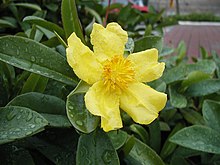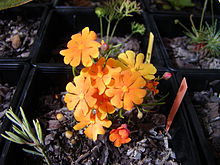Hibbertia: Difference between revisions
→Species: added species with existing articles |
H. mathinnicola in list |
||
| (37 intermediate revisions by 18 users not shown) | |||
| Line 1: | Line 1: | ||
{{Short description|Genus of flowering plants}} |
|||
{{italic title}} |
|||
{{taxobox |
{{Automatic taxobox |
||
| |
|image = Hibbertia scandens orig.jpg |
||
|image_caption = ''[[Hibbertia scandens]]'' |
|||
|image = Hibbertia_stellaris.jpg |
|||
| |
|taxon = Hibbertia |
||
|authority = [[Henry Cranke Andrews|Andrews]]<ref name=APC>{{cite web|title=''Hibbertia''|url= https://biodiversity.org.au/nsl/services/apc-format/display/90786|publisher=Australian Plant Census|access-date=17 March 2021}}</ref> |
|||
|regnum = [[Plant]]ae |
|||
|unranked_divisio = [[Angiosperms]] |
|||
|unranked_classis = [[Eudicots]] |
|||
|unranked_ordo = [[Core eudicots]] |
|||
|ordo = unplaced |
|||
|familia = [[Dilleniaceae]] |
|||
|genus = '''''Hibbertia''''' |
|||
|genus_authority=Andrews<ref name=APNI>{{cite web |url=http://www.anbg.gov.au/cgi-bin/apni?TAXON_NAME=Hibbertia|title=''Hibbertia'' |accessdate=18 March 2011 |work= [[Australian Plant Name Index]] (APNI), IBIS database|publisher = Centre for Plant Biodiversity Research, Australian Government, Canberra}}</ref> |
|||
|subdivision_ranks = [[Species]] |
|subdivision_ranks = [[Species]] |
||
|subdivision = See [[List of Hibbertia species|List of ''Hibbertia'' species]] |
|subdivision = See [[List of Hibbertia species|List of ''Hibbertia'' species]] |
||
|synonyms_ref = <ref name="APC" /> |
|||
|}} |
|||
|synonyms = {{collapsible list | |
|||
* ''Candollea'' <small>[[Labill.]] [[nom. illeg.]]</small> |
|||
* ''Hibbertia'' sect. ''Cyclandra'' <small>[[F.Muell.]] nom. inval.</small> |
|||
* ''Hibbertia'' sect. ''Euhibbertia'' <small>[[Benth.]] nom. inval.</small> |
|||
* ''Eeldea'' <small>[[Théophile Alexis Durand|T.Durand]]</small> |
|||
* ''Hibbertia'' sect. ''Candollea'' <small>[[Ernest Friedrich Gilg|Gilg]]</small> |
|||
* ''Hemistemma'' <small>[[Louis-Marie Aubert du Petit-Thouars|Thouars]] nom. inval., nom. nud.</small> |
|||
* ''Hemistema'' <small>Thouars orth. var.</small> |
|||
* ''Hemistemma'' <small>[[Juss.]] ex Thouars</small> |
|||
* ''Pleurandra'' <small>[[Labill.]]</small> |
|||
* ''Burtonia'' <small>[[Salisb.]] nom. rej.</small> |
|||
* ''Pachynema'' <small>[[R.Br.]] ex [[DC.]]</small> |
|||
* ''Cistomorpha'' <small>[[George Caley|Caley]] ex DC. nom. inval., pro syn.</small> |
|||
* ''Adrastaea'' <small>DC.</small> |
|||
* ''Adrastea'' <small>[[Spreng.]] orth. var.</small> |
|||
* ''Hibbertia sect. Burtonia'' <small>(Salisb.) [[G.Don]]</small> |
|||
* ''Ochrolasia'' <small>[[Turcz.]]</small> |
|||
* ''Huttia'' <small>[[J.Drumm.]] ex [[Harv.]]</small> |
|||
* ''Hemistephus'' <small>J.Drumm. ex Harv.</small> |
|||
* ''Warburtonia'' <small>F.Muell.</small> |
|||
* ''Pachynema sect. Huttia'' <small>(J.Drumm. ex Harv.) Benth. & [[Hook.f.]]</small> |
|||
* ''Pachynema'' <small>R.Br. ex DC.</small> sect. ''Pachynema'' |
|||
* ''Hibbertia sect. Hemistemma'' <small>(Thouars) Benth.</small> |
|||
* ''Hibbertia sect. Pleurandra'' <small>(Labill.) Benth.</small> |
|||
* ''Hibbertia sect. Huttia'' <small>(J.Drumm. ex Harv.) F.Muell.</small> |
|||
* ''Pleurandros'' <small>[[St.-Lag.]] orth. var.</small> |
|||
* ''Pachynema'' sect. ''Stemmatanthus'' <small>F.Muell. & [[Ralph Tate|Tate]] </small> |
|||
* ''Pachynema'' sect. ''Stematanthus'' <small>Gilg & [[Werderm.]] orth. var.</small> |
|||
* ''Hibbertia'' sect. ''Hemistema'' <small>A.D.Chapm. orth. var.</small> |
|||
}} |
|||
}} |
|||
[[Image:Hibbertia grossulariifolia marg rvr email.jpg|thumb|''[[Hibbertia grossulariifolia]]'', [[Margaret River, Western Australia|Margaret River]] region, WA]] |
|||
[[Image:Hibbertia_stellaris.jpg|thumb|''[[Hibbertia stellaris]]'']] |
|||
'''''Hibbertia''''', commonly known as '''guinea flowers''',<ref name="efloraSA" /> is a genus of flowering plants in the family [[Dilleniaceae]]. They are usually shrubs with simple leaves and usually yellow flowers with five [[sepal]]s and five [[petal]]s. There are about 400 species, most of which occur in Australia but a few species occur in New Guinea, New Caledonia, Fiji and [[Madagascar]]. |
|||
'''''Hibbertia''''', or '''Guinea flower''', is a genus of trees, shrubs, trailing shrubs and climbers of the family [[Dilleniaceae]].<ref name=NSW>{{cite web |url=http://plantnet.rbgsyd.nsw.gov.au/cgi-bin/NSWfl.pl?page=nswfl&lvl=gn&name=Hibbertia |title=''Hibbertia''|accessdate=18 March 2011 |author=|work= PlantNET - New South Wales Flora Online |publisher=Royal Botanic Gardens & Domain Trust, Sydney Australia}}</ref><ref name=endemia/> The five-petalled flowers of all species are varying shades of yellow, with the exception of ''[[Hibbertia stellaris|H. stellaris]]'', ''[[Hibbertia miniata|H. miniata]]'' and ''[[Hibbertia selkii|H. selkii]]'', a recently named (1980s) species from the [[Stirling Ranges]], which all have orange flowers. Around 150 species occur in [[Australia]] of which two are also found in [[New Guinea]]. Additionally, 24 species occur in [[New Caledonia]], one of which is also found in [[Fiji]], and one other species is endemic to [[Madagascar]].<ref name=endemia>{{cite web|title=''Hibbertia'' (Genre) |
|||
| url=http://www.endemia.nc/flore/fiche318.html |work=endemia.nc - Faune & Flore de Nouvelle-Calédonie| accessdate=22 March 2011}}</ref> |
|||
The genus is currently being revised by Helmut Toelken of the South Australian Herbarium. |
|||
==Description== |
|||
The genus takes its name from [[George Hibbert]] (1757 - 1837), an eminent [[England|English]] merchant and amateur [[botanist]].<ref name=Corrick>{{cite book|author=Corrick, M.G. and Fuhrer, B.A.| title=Wildflowers of Victoria and adjoining areas| publisher=Bloomings Books|location= Australia | year=2001 | id=ISBN 1876473142}}</ref> |
|||
Plants in the genus ''Hibbertia'' are usually shrubs, rarely climbers, and often form mats. Their leaves are usually arranged alternately along the stems, usually [[Sessility (botany)|sessile]], clustered on short side-branches, and have smooth, rarely toothed or lobed edges. The flowers are usually arranged singly in leaf axils or on the ends of stems and have five sepals, two "outer" sepals slightly overlapping the three "inner" ones. There are five yellow, rarely orange, petals and the [[stamen]]s are usually arranged in three to five groups, sometimes on only one side of the [[Gynoecium#Carpels|carpels]]. There are between two and five carpels, usually free from each other, each containing up to six [[ovule]]s and with a [[Stigma (botany)#Style|style]] on the top. The fruit is a [[Follicle (fruit)|follicle]] containing seeds, usually with an [[aril]].<ref name="RBGV">{{cite web |last1=Toelken |first1=Hellmut R. |title=''Hibbertia'' |url=https://vicflora.rbg.vic.gov.au/flora/taxon/73ff9ddb-8eea-4734-86a6-b32984e34356 |publisher=Royal Botanic Gardens Victoria |access-date=17 March 2021}}</ref><ref name="RBGS">{{cite web |title=''Hibbertia'' |url=https://plantnet.rbgsyd.nsw.gov.au/cgi-bin/NSWfl.pl?page=nswfl&showsyn=&dist=&constat=&lvl=gn&name=Hibbertia |publisher=Royal Botanic Garden Sydney |access-date=17 March 2021}}</ref><ref name=FloraBase>{{FloraBase | name = ''Hibbertia'' | id = 22466}}</ref> |
|||
==Taxonomy and naming== |
|||
==Identification== |
|||
The genus ''Hibbertia'' was first formally described in 1800 by [[Henry Cranke Andrews]] in his book ''The Botanist's Repository for New, and Rare Plants'' and the first species he described was ''H. volubilis'', now known as ''[[Hibbertia scandens|H. scandens]]''.<ref name=APNI>{{cite web|title=''Hibbertia''|url= http://id.biodiversity.org.au/instance/apni/465034|publisher=APNI|access-date=17 March 2021}}</ref><ref name="Andrews">{{cite book |last1=Andrews |first1=Henry Cranke |title=The Botanist's Repository for New, and Rare Plants |volume=2|date=1800 |publisher=H.C.Andrews |location=London |page=126 |url=https://www.biodiversitylibrary.org/item/109209#page/108/mode/1up |access-date=9 July 2020}}</ref><ref name=APC1>{{cite web|title=''Hibbertia scandens''|url= https://biodiversity.org.au/nsl/services/apc-format/display/90786|publisher=Australian Plant Census|access-date=16 March 2021}}</ref> The name ''Hibbertia'' honours [[George Hibbert]], a patron of botany and slave trader.<ref name="efloraSA">{{cite web |title=''Hibbertia'' |url=http://www.flora.sa.gov.au/cgi-bin/speciesfacts_display.cgi?form=speciesfacts&name=Hibbertia |publisher=State Herbarium of South Australia |access-date=17 March 2021}}</ref><ref name=Corrick>{{cite book|author1=Corrick, M.G. |author2=Fuhrer, B.A.| title=Wildflowers of Victoria and adjoining areas| publisher=Bloomings Books|location= Australia | year=2001 | isbn=1876473142}}</ref><ref>{{cite news |last1=Kindy |first1=Dave |title=Scientists want to rename the Hitler beetle — but not for the reason you think |url=https://www.washingtonpost.com/history/2023/09/24/hitler-beetle-offensive-species-names/ |work=Washington Post |date=21 September 2023}}</ref> The common name, guinea flower reflects the resemblance of the flowers to the colour and shape of the [[Guinea (coin)|guinea]] coin.<ref name="APS">{{cite web |title=''Hibbertia scandens'' |url=https://resources.austplants.com.au/plant/hibbertia-scandens/ |publisher=Australian Plants Society NSW |access-date=17 March 2021}}</ref> |
|||
Given the similarity in flower colour and shape (In nearly all species, the five petals are obovate), the number of [[stamen]]s is a useful method of identification as this can vary widely from 4 to about 200 depending on species. |
|||
==Species== |
===Species list=== |
||
See [[List of Hibbertia species|List of ''Hibbertia'' species]] |
|||
==References== |
|||
[[Image:Hibbertia scandens orig.jpg|thumb|''[[Hibbertia scandens]]'']] |
|||
{{Reflist}} |
|||
{{Taxonbar|from=Q2709465}} |
|||
[[Image:Hibbertia grossulariifolia marg rvr email.jpg|thumb|''[[Hibbertia grossulariifolia]]'', [[Margaret River, Western Australia|Margaret River]] region, WA]] |
|||
{{Authority control}} |
|||
Species include:<ref name=APNI/> |
|||
*''[[Hibbertia amplexicaulis]]'' |
|||
*''[[Hibbertia aspera]]'' - Rough Guinea-flower |
|||
*''[[Hibbertia banksii]]'' |
|||
*''[[Hibbertia basaltica]]'' |
|||
*''[[Hibbertia bracteata]]'' |
|||
*''[[Hibbertia cistiflora]]'' - Rock Rose Guinea-flower |
|||
*''[[Hibbertia cuneiformis]]'' - Cut-leaf Hibbertia |
|||
*''[[Hibbertia dentata]]'' - Twining Guinea-flower |
|||
*''[[Hibbertia diffusa]]'' |
|||
*''[[Hibbertia empetrifolia]]'' - Tangled Guinea-flower |
|||
*''[[Hibbertia fasciculata]]'' |
|||
*''[[Hibbertia furfuracea]]'' |
|||
*''[[Hibbertia grossulariifolia]]'' - Gooseberry-leaved Guinea-flower |
|||
*''[[Hibbertia hirta]]'' |
|||
*''[[Hibbertia hypericoides]]'' - Yellow Buttercups |
|||
*''[[Hibbertia incana]]'' - Prickly Guinea-flower |
|||
*''[[Hibbertia linearis]]'' |
|||
*''[[Hibbertia longifolia]]'' |
|||
*''[[Hibbertia miniata]]'' - Orange Guinea-flower |
|||
*''[[Hibbertia obtusifolia]]'' - Hoary Guinea-flower |
|||
*''[[Hibbertia pedunculata]]'' - Stalked Guinea-flower |
|||
*''[[Hibbertia procumbens]]'' |
|||
*''[[Hibbertia prostrata]]'' - Bundled Guinea-flower |
|||
*''[[Hibbertia riparia]]'' - Erect Guinea-flower |
|||
*''[[Hibbertia scandens]]'' – Climbing Guinea-flower or Snake Vine |
|||
*''[[Hibbertia selkii]]'' |
|||
*''[[Hibbertia serrata]]'' |
|||
*''[[Hibbertia sericea]]'' - Silky Guinea-flower |
|||
*''[[Hibbertia serpyllifolia]]'' |
|||
*''[[Hibbertia stellaris]]'' – Star Guinea-flower |
|||
*''[[Hibbertia truncata]]'' - Port Campbell Guinea-flower |
|||
*''[[Hibbertia vestita]]'' - Hairy Guinea-flower |
|||
==References== |
|||
{{reflist}} |
|||
[[Category:Hibbertia| ]] |
[[Category:Hibbertia| ]] |
||
[[Category:Eudicot genera]] |
[[Category:Eudicot genera]] |
||
[[Category:Taxa named by Henry Cranke Andrews]] |
|||
Latest revision as of 21:23, 12 March 2024
| Hibbertia | |
|---|---|

| |
| Hibbertia scandens | |
| Scientific classification | |
| Kingdom: | Plantae |
| Clade: | Tracheophytes |
| Clade: | Angiosperms |
| Clade: | Eudicots |
| Order: | Dilleniales |
| Family: | Dilleniaceae |
| Genus: | Hibbertia Andrews[1] |
| Species | |
| Synonyms[1] | |
|
List
| |


Hibbertia, commonly known as guinea flowers,[2] is a genus of flowering plants in the family Dilleniaceae. They are usually shrubs with simple leaves and usually yellow flowers with five sepals and five petals. There are about 400 species, most of which occur in Australia but a few species occur in New Guinea, New Caledonia, Fiji and Madagascar.
Description[edit]
Plants in the genus Hibbertia are usually shrubs, rarely climbers, and often form mats. Their leaves are usually arranged alternately along the stems, usually sessile, clustered on short side-branches, and have smooth, rarely toothed or lobed edges. The flowers are usually arranged singly in leaf axils or on the ends of stems and have five sepals, two "outer" sepals slightly overlapping the three "inner" ones. There are five yellow, rarely orange, petals and the stamens are usually arranged in three to five groups, sometimes on only one side of the carpels. There are between two and five carpels, usually free from each other, each containing up to six ovules and with a style on the top. The fruit is a follicle containing seeds, usually with an aril.[3][4][5]
Taxonomy and naming[edit]
The genus Hibbertia was first formally described in 1800 by Henry Cranke Andrews in his book The Botanist's Repository for New, and Rare Plants and the first species he described was H. volubilis, now known as H. scandens.[6][7][8] The name Hibbertia honours George Hibbert, a patron of botany and slave trader.[2][9][10] The common name, guinea flower reflects the resemblance of the flowers to the colour and shape of the guinea coin.[11]
Species list[edit]
References[edit]
- ^ a b "Hibbertia". Australian Plant Census. Retrieved 17 March 2021.
- ^ a b "Hibbertia". State Herbarium of South Australia. Retrieved 17 March 2021.
- ^ Toelken, Hellmut R. "Hibbertia". Royal Botanic Gardens Victoria. Retrieved 17 March 2021.
- ^ "Hibbertia". Royal Botanic Garden Sydney. Retrieved 17 March 2021.
- ^ "Hibbertia". FloraBase. Western Australian Government Department of Biodiversity, Conservation and Attractions.
- ^ "Hibbertia". APNI. Retrieved 17 March 2021.
- ^ Andrews, Henry Cranke (1800). The Botanist's Repository for New, and Rare Plants. Vol. 2. London: H.C.Andrews. p. 126. Retrieved 9 July 2020.
- ^ "Hibbertia scandens". Australian Plant Census. Retrieved 16 March 2021.
- ^ Corrick, M.G.; Fuhrer, B.A. (2001). Wildflowers of Victoria and adjoining areas. Australia: Bloomings Books. ISBN 1876473142.
- ^ Kindy, Dave (21 September 2023). "Scientists want to rename the Hitler beetle — but not for the reason you think". Washington Post.
- ^ "Hibbertia scandens". Australian Plants Society NSW. Retrieved 17 March 2021.
